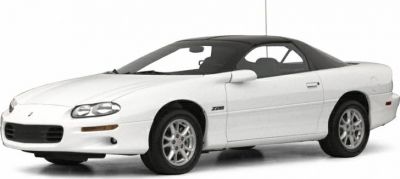 1993 Chevrolet Camaro IV Dimensions, Size & Specs
1993 Chevrolet Camaro IV Dimensions, Size & SpecsMeasurements of the 1993 Chevrolet Camaro IV, engineered for optimal performance and comfort
| Dimensions | |
|---|---|
| Length: | 4907 mm193.2 in16.1 ft |
| Width: | 1883 mm74.1 in6.2 ft |
| Height: | 1303 mm51.3 in4.3 ft |
| Trunk Capacity: | 365-366 liter12.9-12.9 cu ft |
| Trunk Capacity (Max): | 929-930 liter32.8-32.8 cu ft |
| Weight Specifications | |
| Curb Weight: | 1475-1644 kg3252-3624 lbs |
| Maximal permitted Weight: | 1922 kg4237 lbs |
| Tire Specifications | |
| Rims Sizes: | 16-inch rims:
|
| Tire Sizes: |
|
The Chevrolet Camaro IV, representing the 4th generation of the iconic Camaro lineup, was produced from 1992 to 1998, with the 1993 model year standing out as a prime example of this era. This generation is specifically designed as a sporty coupe, showcasing a blend of performance and refined aesthetics. The Camaro IV measures 4907 mm (193.2 inches) in length and spans a width between 1882 mm (74.1 inches) and 1883 mm (74.1 inches), making it a substantial contender in the midsize sports coupe segment. Standing at a height of 1303 mm (51.3 inches), the car’s low-profile stance complements its aerodynamic silhouette. Weight varies across different trims and configurations, with a curb weight range from 1475 kg (3251 lbs) to 1644 kg (3624 lbs), and a maximum weight capacity of 1922 kg (4238 lbs), balancing performance dynamics with structural robustness. Its luggage capacity offers practical space utilization, featuring 365 to 366 liters (12.9 to 12.9 cubic feet) behind the rear seats. For enhanced cargo flexibility, folding the rear seats expands the volume significantly to approximately 929 to 930 liters (32.8 to 32.8 cubic feet), an impressive feature for a sports coupe of its class. The Camaro IV rides on rim sizes of 7.5J x 16 or 8J x 16, paired with tires sized 215/60 R16, 235/55 R16, or 235/55 R16V, allowing for a balanced grip and handling suitable for both everyday driving and spirited performance. Overall, the 4th generation Camaro maintains a strong presence within Chevrolet’s muscle car heritage, offering a blend of size, style, and practical usability that caters well to enthusiasts and daily drivers alike.
Discover the standout features that make the 1993 Chevrolet Camaro IV a leader in its class
Have a question? Please check our knowledgebase first.
The 1993 Chevrolet Camaro IV measures 4907 mm (193.2 inches) in length, making it a fairly long coupe that emphasizes a sporty yet spacious design. Its width ranges between 1882 mm and 1883 mm (74.1 to 74.2 inches), providing a stable and wide stance on the road, contributing to both aesthetics and handling. The height is a low 1303 mm (51.3 inches), which supports the aerodynamic profile typical of performance coupes of the era. These proportions give the Camaro IV a sleek and aggressive look while maintaining a practical footprint for both drivers and passengers.
The curb weight of the Chevrolet Camaro IV varies between 1475 kg to 1644 kg (approximately 3251 to 3623 pounds), depending on the specific trim and options equipped. This weight range balances the car's sporty performance with structural safety and comfort. Its maximum weight, which includes passengers, cargo, and fuel, is rated at 1922 kg (about 4239 pounds). These weight characteristics influence the Camaro IV's acceleration, braking, and fuel efficiency, reflecting a car built to offer a satisfying driving experience without compromising on durability.
The 1993 Chevrolet Camaro IV offers a luggage capacity of 365 to 366 liters (around 12.9 to 12.9 cubic feet) when all seats are in use. For a sports coupe, this is a decent amount of space for daily essentials or weekend trips. When the rear seats are folded down, the cargo volume significantly increases to 929 to 930 liters (roughly 32.8 to 32.9 cubic feet), allowing for much more flexibility in carrying larger items. This versatility makes the Camaro IV practical for both sporty driving and occasional cargo-hauling needs.
The Chevrolet Camaro IV comes equipped with rim sizes including 7.5J x 16 and 8J x 16, paired with tire sizes such as 215/60 R16, 235/55 R16, and 235/55 R16V, which contribute to balanced performance characteristics. The wider tires, especially the 235 mm wide options, enhance road grip and stability during spirited driving, which is essential for a car designed with sporty intentions. These tire and rim combinations offer improved handling responsiveness and cornering capability, making the Camaro IV an engaging vehicle for enthusiasts.
With a length of 4907 mm (193.2 inches), a width of roughly 1882-1883 mm (74.1-74.2 inches), and a height of 1303 mm (51.3 inches), the Chevrolet Camaro IV fits comfortably within the dimensions of a typical single-car residential garage. Standard garages usually have interior widths around 2.4 to 2.7 meters (94 to 106 inches) and lengths of approximately 5.5 to 6 meters (217 to 236 inches), so the Camaro's dimensions leave enough clearance for opening doors and maneuvering. This makes it convenient for most Camaro IV owners to park the car safely indoors without spatial concerns.
Compared to the third-generation Camaro, which was produced from 1982 to 1992, the fourth-generation Camaro (1993-1998) is generally larger and more refined. The Camaro IV’s length of 4907 mm represents an increase over the earlier model’s shorter body, contributing to improved interior space and added road presence. The width also saw a modest gain, enhancing stability, while the lower height of 1303 mm lends to a sleeker, more aerodynamic profile. These dimensional updates reflect Chevrolet’s intent to modernize the Camaro, providing a more spacious yet sport-oriented coupe than the third generation.
When compared with similar sports coupes of the early 1990s like the Ford Mustang SN-95 or Nissan 300ZX Z32, the Chevrolet Camaro IV is relatively long and wide, emphasizing a muscular stance. For instance, the Mustang SN-95 typically measures about 4784 mm (188.3 inches) in length and around 1834 mm (72.2 inches) in width, making the Camaro slightly longer and wider. The Nissan 300ZX is shorter and lower in height, favoring a more compact, aerodynamic design. The Camaro’s larger size offers a blend of classic American muscle proportions with spaciousness, distinguishing it from its peers who often focus more on compact agility.
The Camaro IV was typically fitted with 16-inch rims, either 7.5J or 8J width, paired with tires sized at 215/60 R16 or 235/55 R16 variants. These tire setups allowed for substantial contact patches with the road, enhancing grip and handling performance. The wider tire options, particularly the 235 mm width tires, helped improve cornering stability and reduced understeer, which complements the car’s sporty suspension tuning. The 16-inch wheels balance ride comfort with sportiness, providing a driving experience that is both responsive and relatively smooth for a performance coupe of its era.
While specific ground clearance figures for the Camaro IV are not universally standardized, the car’s low height of 1303 mm (51.3 inches) and performance-oriented suspension suggest a relatively low ground clearance, likely around 120 to 130 mm (4.7 to 5.1 inches). This low ride height favors improved aerodynamics and handling on paved roads but demands careful attention over speed bumps and uneven surfaces. The low ground clearance is typical for sports coupes designed for spirited driving, resulting in greater cornering stability but limiting usability on rough terrain or poorly maintained roads.
The Camaro IV, launched in 1993, marked a significant advancement over its predecessors, with a more aerodynamic and modern design characterized by smoother body lines and a more aggressive front fascia. Performance-wise, the fourth generation introduced refined V6 and V8 engine options that provided better power output and efficiency. Additionally, the platform was updated to improve handling and ride comfort, offering a more balanced driving experience. Technological enhancements included improved suspension geometry, upgraded brakes, and better safety features, making the Camaro IV a more compelling and competitive sports coupe in the 1990s market.
Discover similar sized cars.

| Production: | 1982-1992 |
|---|---|
| Model Year: | 1982 |
| Length: | 4833 mm190.3 in |
| Width: | 1838 mm72.4 in |
| Height: | 1264 mm49.8 in |

| Production: | 2023-present |
|---|---|
| Model Year: | 2023 |
| Length: | 4959-4966 mm195.2-195.5 in |
| Width: | 2113 mm83.2 in |
| Height: | 1353 mm53.3 in |

| Production: | 1998-2002 |
|---|---|
| Model Year: | 1998 |
| Length: | 4907-4915 mm193.2-193.5 in |
| Width: | 1882 mm74.1 in |
| Height: | 1300-1322 mm51.2-52.0 in |

| Production: | 1970-1981 |
|---|---|
| Model Year: | 1970 |
| Length: | 4775-5020 mm188.0-197.6 in |
| Width: | 1892 mm74.5 in |
| Height: | 1270-1300 mm50.0-51.2 in |
